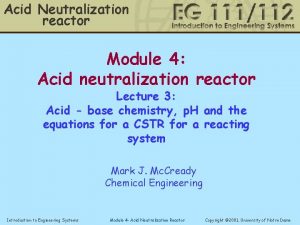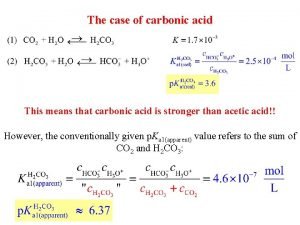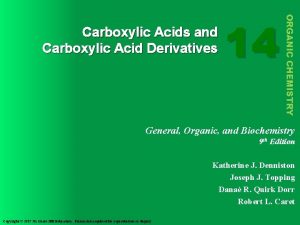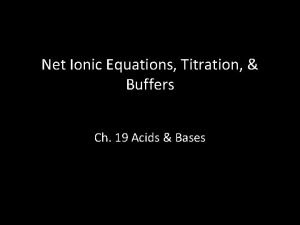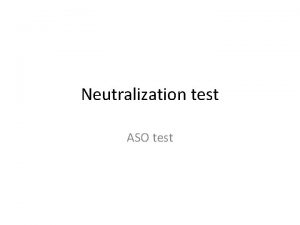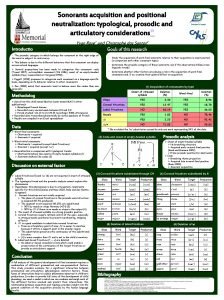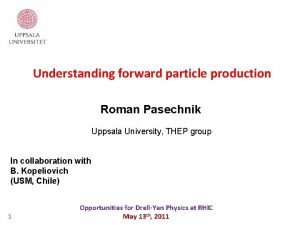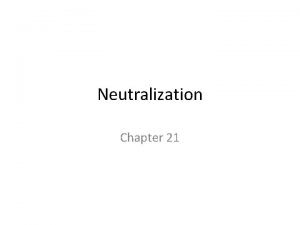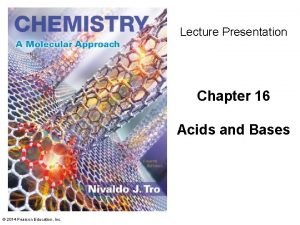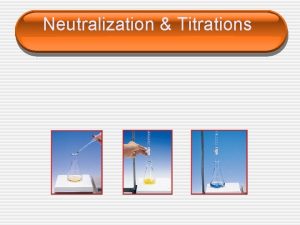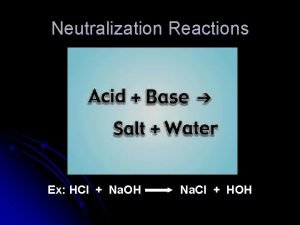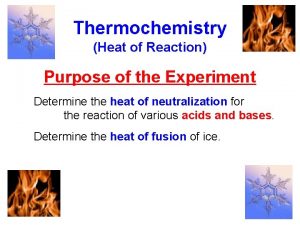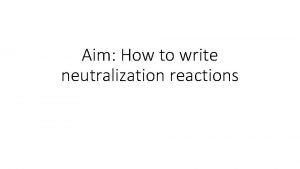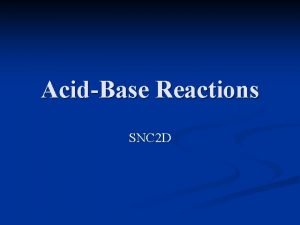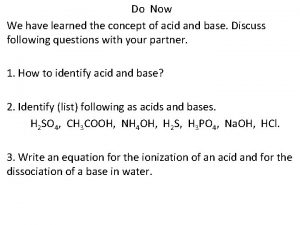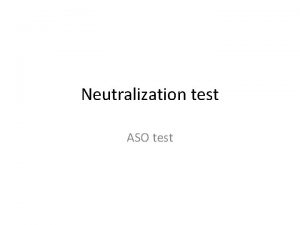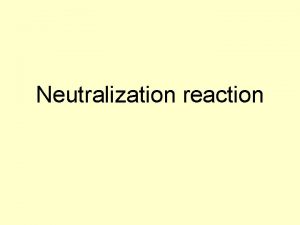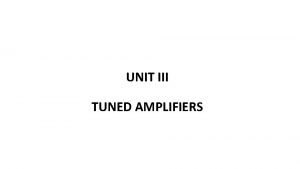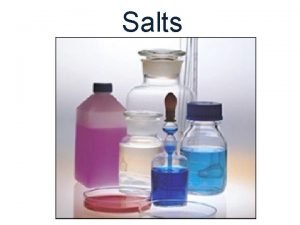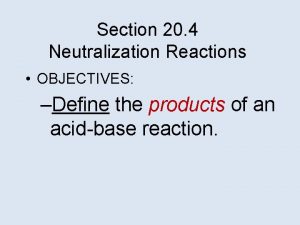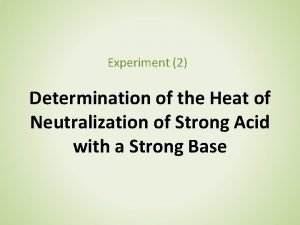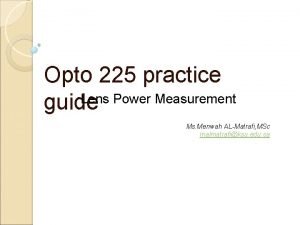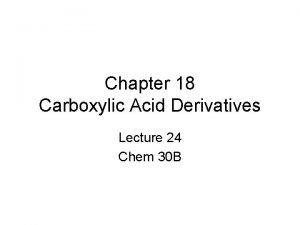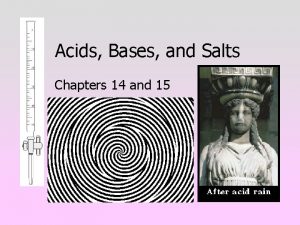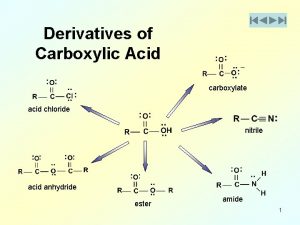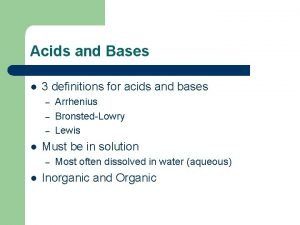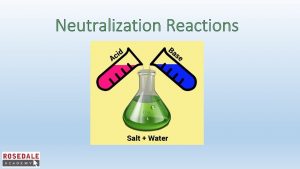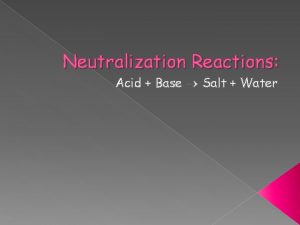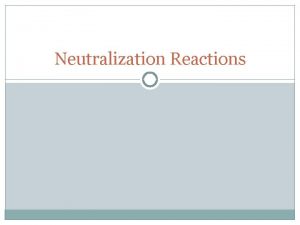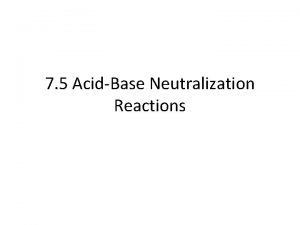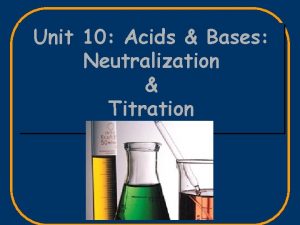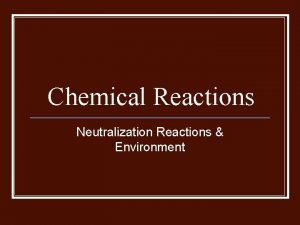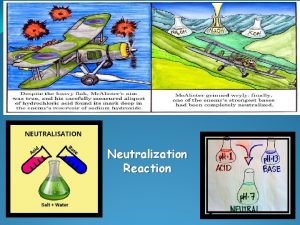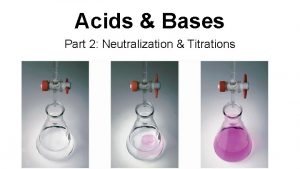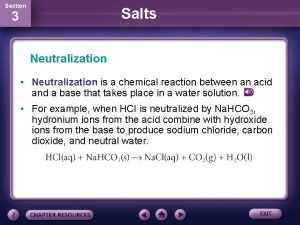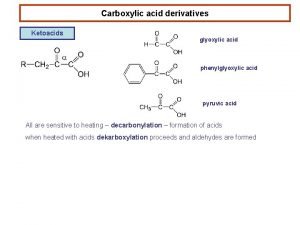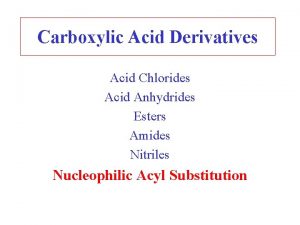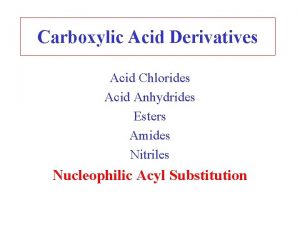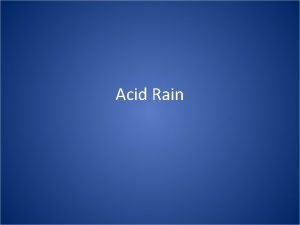Acid Neutralization Reactor Module 4 Acid neutralization reactor


































- Slides: 34

Acid Neutralization Reactor Module 4: Acid neutralization reactor Lecture 2: Analysis of the feed tank and the reactor for the case of no reaction Mark J. Mc. Cready Chemical Engineering Introduction to Engineering Systems Module 4 - Acid Neutralization Reactor Copyright © 2001, University of Notre Dame

Outline for today n n Quick review of mass balance equations Analysis of the reactor for 2 feeds but no reaction u n Expectation of a Steady State. . . Analysis of the feed tank that is draining by gravity u How does the depth of liquid affect the flow rate? F Bernoulli equation to relate effects of gravity, pressure and velocity within a fluid Introduction to Engineering Systems Module 4 - Acid Neutralization Reactor Copyright © 2001, University of Notre Dame

Reactor, what will the exit concentration be? Acid in, 1 Control volume 3 Base in, 2 Flow out, 3 Introduction to Engineering Systems Module 4 - Acid Neutralization Reactor Copyright © 2001, University of Notre Dame

Feed Tank, how fast does it drain? Introduction to Engineering Systems Module 4 - Acid Neutralization Reactor Copyright © 2001, University of Notre Dame

Feed Tank, how fast does it drain? We will use this control volume for the tank h Introduction to Engineering Systems Module 4 - Acid Neutralization Reactor Copyright © 2001, University of Notre Dame

Start of new material n n First we will analyze the reactor using the mass balance equations. Today, there will be no reaction. But, we will allow for inlet streams of different concentration. We will see that if the inlet concentrations and flows are constant, a steady - state is expected where there is no change in the concentration with time in the tank. Introduction to Engineering Systems Module 4 - Acid Neutralization Reactor Copyright © 2001, University of Notre Dame

Today, we will not do reaction, just use the tank as a mixer Salt solution in, 1 Control volume 3 Another salt solution in, 2 Flow out, 3 Introduction to Engineering Systems Module 4 - Acid Neutralization Reactor Copyright © 2001, University of Notre Dame

Recall Mass Balance n General mass balance equation for a fixed control volume u Rate of Accumulation = u Rate In - Rate Out + Production by reaction- u n Consumption by reaction Overall r j - density of stream j, (mass/length 3 ) n Component mass (mole) balance qj -- volumetric flow rate of stream j, (length 3 /time) V -- active volume of reactor, (length 3) cji-- molar concentration of species i in stream j, (moles/ length 3 ) ri -- molar reaction rate per volume (moles/ (length 3 -time)) Introduction to Engineering Systems Module 4 - Acid Neutralization Reactor Copyright © 2001, University of Notre Dame

Today, we will not do reaction, just use the tank as a mixer Salt solution in, 1 Control volume Another salt solution in, 2 Flow out, 3 Introduction to Engineering Systems Module 4 - Acid Neutralization Reactor Copyright © 2001, University of Notre Dame

Mass Balance A sketch of our problem looks like: FWe see two inputs and one output FOverall mass balance FComponent 3 -- volumetric flow rate of stream j FV -- active volume of reactor (m 3) 2 3 mass balance, for salt F qj Fcjsalt 1 (m 3/s) -- molar concentration of salt in stream j (moles/m 3) The reaction term is 0!! Introduction to Engineering Systems Module 4 - Acid Neutralization Reactor Copyright © 2001, University of Notre Dame

Simplifications n n Flowrates in are not changing in time Reactor is filled at the beginning Thus, overall mass balance tells us nothing we don’t find obvious. What about the salt balance? We expect that it will tell us what comes out, if we know what goes in. Introduction to Engineering Systems Module 4 - Acid Neutralization Reactor Copyright © 2001, University of Notre Dame

Balance equation n The salt balance equation# n Can be solved to give… F You can solve this equation by numerical integration A green background slide means that we don’t expect you to get the answer, because we used mathematics you may not yet understand. But, the answer will be insightful. # Introduction to Engineering Systems Module 4 - Acid Neutralization Reactor Copyright © 2001, University of Notre Dame

Plot of the concentration n We see that there is an initial transient (exponential) that depends on reactor volume and then a steady state is reached after which there is no further time variation. (If the inlets remain constant!) n Steady state answer: Introduction to Engineering Systems Module 4 - Acid Neutralization Reactor Initial concentration =0 Note different volumes and abscissa scales Initial concentration =0 Copyright © 2001, University of Notre Dame

Steady state concentration n n For this example we have q 1 = 10 m 3/s, c 1 = 2 moles/ m 3 q 2 = 5 m 3/s, c 2 = 3 moles/m 3 Thus: u q 3 = (10 + 5)= 15 m 3/s Note different volumes and abscissa scales Introduction to Engineering Systems Module 4 - Acid Neutralization Reactor Copyright © 2001, University of Notre Dame

Steady state behavior? n Is there always a steady state if we have steady inputs to a reactor? u Maybe n n this is obvious ? ? Should we have even bothered to integrate? Think of some examples…. Introduction to Engineering Systems Module 4 - Acid Neutralization Reactor Copyright © 2001, University of Notre Dame

Feed Tank, how fast does it drain? Now let’s examine a feed tank We need a new control volume This tank has an exit stream, but no inlet streams. h Introduction to Engineering Systems Module 4 - Acid Neutralization Reactor Copyright © 2001, University of Notre Dame

Draining tank A sketch of our problem looks like: FWe have just one output FOverall mass balance: Control valve h since u 3, A 3 we can use the chain rule to get area of exit pipe, velocity of fluid leaving in stream 3. we know the flowrate and velocity are related by But…, how do we get u 3? thus Introduction to Engineering Systems Module 4 - Acid Neutralization Reactor Copyright © 2001, University of Notre Dame

Draining tank Factors that affect exit liquid flowrate F Control valve, K FATank --not really Fh-- yup! FA 3 -- yes, consider a h u 3, A 3 hypodermic needle area and velocity FHow open the valve is (as denoted by K) Fg, gravity -- well of course • can’t drain a tank on the space station with gravity! h=0 4” pipe versus a Introduction to Engineering Systems Module 4 - Acid Neutralization Reactor Copyright © 2001, University of Notre Dame

Pressure-depth relation n Common occurrence in the summer Wow, my ears hurt n Basic equation of hydrostatics: Introduction to Engineering Systems Module 4 - Acid Neutralization Reactor r =density g=gravitation constant P=pressure h=depth of liquid Copyright © 2001, University of Notre Dame

Effect of depth n n n So we expect that if the depth is greater, the flow rate will be faster Can we quantify this? Recall from Physics, u Consider conversion of potential to kinetic energy for a fluid blob. F First we take the case of no “friction” or drag Introduction to Engineering Systems Module 4 - Acid Neutralization Reactor Copyright © 2001, University of Notre Dame

KE--PE relation, we get velocity n Consider a blob of fluid in our tank. It will follow the path shown with no friction Control valve, K a h m g h = PE u 3, A 3 area and velocity h=0 h h=0 b DKE+ DPE = 0 1/2 m (ub 2 - ua 2 ) +mg (hb-ha) = 0 ub 2 = 2 g Dh KE = 1/2 m u 2 Introduction to Engineering Systems Module 4 - Acid Neutralization Reactor Copyright © 2001, University of Notre Dame

Draining tank with control valve n n n We see that the velocity will not depend on the area of exit pipe. Now for the real system we have a control valve that can open and close, the easiest way to deal with this is to consider that it causes a “loss” of energy. DKE + DPE + “losses” = 0 1/2 m (ub 2 - ua 2 ) +mg(hb-ha) + K/2 ub 2 = 0 (1+K) ub 2 = 2 g Dh Introduction to Engineering Systems Module 4 - Acid Neutralization Reactor As K increases, velocity decreases. As the valve is closed, K increases! Copyright © 2001, University of Notre Dame

WHITE BOARD STUFF n n Notre Dame law of wind direction How momentum of fluid is converted to an increase in pressure as it impinges on a wall? u Student--University paradox u How the pressure must increase if the fluid is to be slowed down. n n Work--Energy Principle from Physics Bernoulli Equation Introduction to Engineering Systems Module 4 - Acid Neutralization Reactor Copyright © 2001, University of Notre Dame

Bernoulli equation The relation between the pressure, the velocity, the change in height and frictional losses: n For our draining tank, there is no pressure change, and the relation between u and h is n n Now we can go back to the mass balance and finish solving the problem Introduction to Engineering Systems Module 4 - Acid Neutralization Reactor Copyright © 2001, University of Notre Dame

White board Introduction to Engineering Systems Module 4 - Acid Neutralization Reactor Copyright © 2001, University of Notre Dame

White board Introduction to Engineering Systems Module 4 - Acid Neutralization Reactor Copyright © 2001, University of Notre Dame

White board Introduction to Engineering Systems Module 4 - Acid Neutralization Reactor Copyright © 2001, University of Notre Dame

White Board Introduction to Engineering Systems Module 4 - Acid Neutralization Reactor Copyright © 2001, University of Notre Dame

Draining tank Recall the mass balance We use our relation, note that the “b” subscript is now “ 3” Control valve, K h h=0 To get a final equation that can be solved. . . FYou u 3, A 3 area and velocity can solve this numerically to find how h changes in time. Introduction to Engineering Systems Module 4 - Acid Neutralization Reactor Copyright © 2001, University of Notre Dame

Draining tank This one has a rather ugly analytical solution… h(t)= Here is a plot of some results K=12 K varies from 0 to 12 K=0 Introduction to Engineering Systems Module 4 - Acid Neutralization Reactor Copyright © 2001, University of Notre Dame

Filling/draining tank (for homework) n What do the equations for this tank look 2 like? 1 Substitute for the unknown flow rate and the liquid depth 3 3 Now use the Bernoulli equation n This last equation can be easily solved numerically to get height versus time. Introduction to Engineering Systems Module 4 - Acid Neutralization Reactor Copyright © 2001, University of Notre Dame

Recap (mixing tank) n n Component mass balance for “mixing 3 tank” 1 2 The behavior is: Steady-state answer Introduction to Engineering Systems Module 4 - Acid Neutralization Reactor Copyright © 2001, University of Notre Dame

Recap (draining tank) n Overall mass balance for draining tank Control valve, K u 3, A 3 area and velocity K varies from 0 to 12 Introduction to Engineering Systems Module 4 - Acid Neutralization Reactor Copyright © 2001, University of Notre Dame

Recap Bernoulli equation n n Bernoulli equation Useful engineering equation to describe large-scale fluid flows. It relates changes in pressure, height and velocity and accounts for frictional losses. Introduction to Engineering Systems Module 4 - Acid Neutralization Reactor Copyright © 2001, University of Notre Dame
 Neutralization reactor
Neutralization reactor Acid and base products
Acid and base products Titration equation
Titration equation Carbonic acid neutralization
Carbonic acid neutralization Carboxylic acid + base
Carboxylic acid + base Neutralization equation
Neutralization equation C device module module 1
C device module module 1 Aso neutralization test
Aso neutralization test Positional neutralization
Positional neutralization Neutralization
Neutralization Example for neutralization reaction
Example for neutralization reaction Antigen antibody
Antigen antibody Neutralization reaction
Neutralization reaction Neutralization titrations
Neutralization titrations Ma x va mb x vb
Ma x va mb x vb Bomb calorimeter uses
Bomb calorimeter uses Writing neutralization reactions
Writing neutralization reactions Whats a neutralization reaction
Whats a neutralization reaction Neutralization formula
Neutralization formula Aso neutralization test
Aso neutralization test Whats a neutralization reaction
Whats a neutralization reaction Neutralization double replacement
Neutralization double replacement Single tuned amplifier derivation of quadratic formula
Single tuned amplifier derivation of quadratic formula Preparation of insoluble salts
Preparation of insoluble salts Example of neutralization reaction
Example of neutralization reaction Hexagonal phospholipid neutralization
Hexagonal phospholipid neutralization Thio neutralization
Thio neutralization Neutralization of cream
Neutralization of cream Qneu
Qneu Lens power measurement
Lens power measurement N-ethyl-3-butanolactam
N-ethyl-3-butanolactam What are the seven strong acids
What are the seven strong acids Hydrolysis of nitrile group
Hydrolysis of nitrile group Example of acid-fast bacteria
Example of acid-fast bacteria Hcl lewis acid or base
Hcl lewis acid or base
